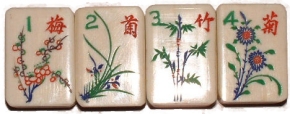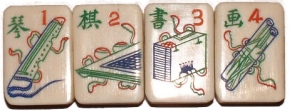| OVERVIEW: The Tiles ⇒ Characters ⇒ Circles ⇒ Bamboos ⇒ Dragons ⇒ Winds ⇒ Flowers and Seasons ⇒ Plain tiles ⇒ jokers ⇒ Accessories ⇒ Dice ⇒ Tallies ⇒ More on Tallies ⇒ Wind discs and the Tong Box ⇒ Racks |
.
The Tiles
A Mah-Jong set has 144 tiles (traditionally made from ivory or bone, dove-tailed into bamboo).
These can be divided into sets of Characters, Circles, Bamboos, Dragons, Winds, Flowers and Seasons. Characters, Circles and Bamboos are known as “suits”. Often there also 4 spare tiles, 4 blank tiles and sometimes another 4 Joker tiles.
Tiles can be classified into “major” and “minor” tiles. major tiles are worth more than minor tiles. Suit tiles have both types. Dragons and Winds are major tiles, but are also known as “honour” tiles as they are able to increase your score further by doubling. Flowers and Seasons are bonus tiles.
.
Characters
There are 4 sets of 9 tiles numbered 1 to 9, showing the Chinese symbol for the numbers 10,000 to 90,000. The 1 and 9 Characters are major tiles. The 2 to 8 Characters are minor tiles.
 The appropriate Arabic numeral is also marked on the tile. It’s typical of sets made for export to the West.
The appropriate Arabic numeral is also marked on the tile. It’s typical of sets made for export to the West.
.
Circles
There are 4 sets of 9 tiles numbered 1 to 9. The tiles show the appropriate number of Circles. The 1 and 9 Circles are major tiles. The 2 to 8 Circles are minor tiles.

.
Bamboos
There are 4 sets of 9 tiles numbered 1 to 9. The tiles show the appropriate number of Bamboos, except for the 1 Bamboos which often shows a picture of a bird (usually a sparrow or rice-bird). The 1 and 9 Bamboos are major tiles. The 2 to 8 Bamboos are minor tiles.

.
Dragons

There are 4 Red Dragons, 4 Green Dragons and 4 White Dragons. White Dragons are traditionally denoted by a blank tile and sometimes by a rectangle.
All Dragons are honour tiles.
.
.
Winds
There are 4 East Winds, 4 West Winds, 4 North Winds and 4 South Winds. East Wind has special significance. Winds are – sequenced as follows: 1 – East, 2 – South, 3 – West, 4 – North.
By this sequence, East and West are the opposite of our world view. All Winds are honour tiles.

.
Flowers and Seasons
There are 4 Flower tiles and 4 Season tiles, numbered 1 to 4. This number associates the tile with the Wind of the same number. The depiction of Flowers and Seasons varies between sets. Note that in the Flower tiles shown below, Bamboo and Chrysanthemum are not in the normal order.

1 – Plum
2 – Orchid (Lily)
3 – Bamboo (normally 4)
4 – Chrysanthemum (normally 3)

1 – Spring
2 – Summer
3 – Autumn
4 – Winter
Sometimes the Seasons are depicted as 1 – Fisher, 2 – Woodcutter, 3 – Farmer, 4 – Scholar. The above illustrations are thought to depict the Four Arts of the Chinese Scholar: 1 – Zither (a stringed instrument), 2 – Board Game (Go / Weiqi), 3 – Calligraphy, 4 – Painting. There is a lot of variation in the illustrations used for the Flower and Seasons – and is a chance for the engraver to show his skill.
.
Plain tiles

Most sets have 4 spare plain tiles of use when a tile is lost.
(They often look exactly the same as a White Dragon).
.
Jokers

Some sets also have 4 joker tiles. These are “wild” and are used to replace the 2 Bamboos in a special form of the game called the “goulash”.
.
Accessories
 Dice
Dice
Two dice are used at the start of the game to determine where the wall is to be broken prior to dealing out the tiles. The 1 and 4 on the dice are red – an auspicious colour – and the other numbers black.
.
Tallies
There are four types of tally sticks in a set and they are traditionally made from bone or ivory. The number of dots on a tally is not necessarily indicative of its value. At the beginning of the game each player is given tallies with a total value of 2,000 points. There are several varieties of tally sticks.
Here is one typical set:
In practice, you may find 2,000 points for each player to be insufficient. In this case, I would suggest introducing another token to stand for 1,000 points and to distribute (say) 3 of these to each player. One might, for example, use a 10p (or 10 cents) coin.
Wind discs and the Tong Box
 Some sets include four small counters which denote the four Winds. These
Some sets include four small counters which denote the four Winds. These  are used to determine who is to be what Wind at the start of the game. They are then placed in a “Tong box” (or “Chuang-tzu” ) to show the prevailing Wind (initially East). When they are not present then the normal Wind tiles are used instead. Sometimes the game includes a Wind disk indicator.
are used to determine who is to be what Wind at the start of the game. They are then placed in a “Tong box” (or “Chuang-tzu” ) to show the prevailing Wind (initially East). When they are not present then the normal Wind tiles are used instead. Sometimes the game includes a Wind disk indicator.
.
Racks
Four racks are used to hold each player’s tiles. Sometimes one of the racks is darker coloured and is used by East Wind. This rack is passed around the players as East Wind changes.
 The larger, decorated rack has a lift up lid which reveals compartments where tallies can be stored
The larger, decorated rack has a lift up lid which reveals compartments where tallies can be stored
Also see questions on Equipment
.
.
.
.
.
.
.
.
.
.
.
.
.
.
.
.
.
.
.
.
.
.
.
.
.
.
.
